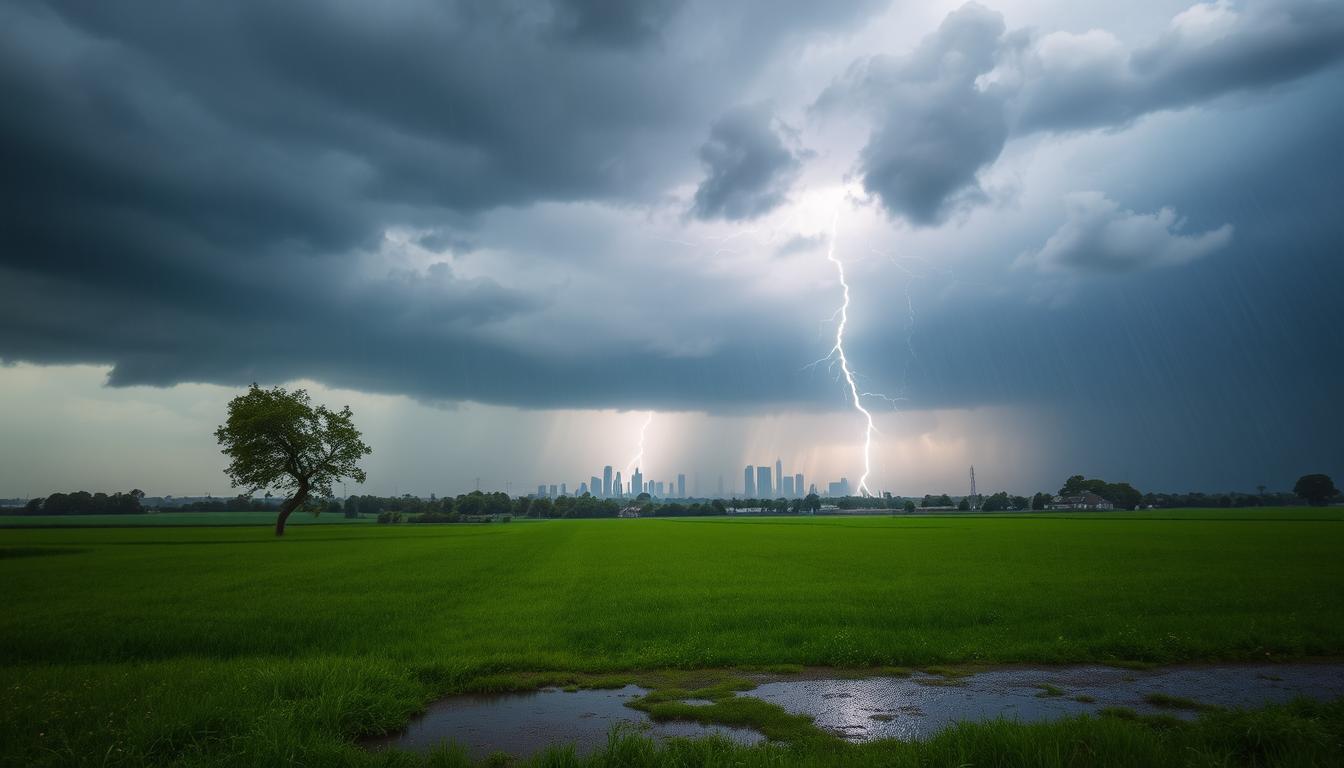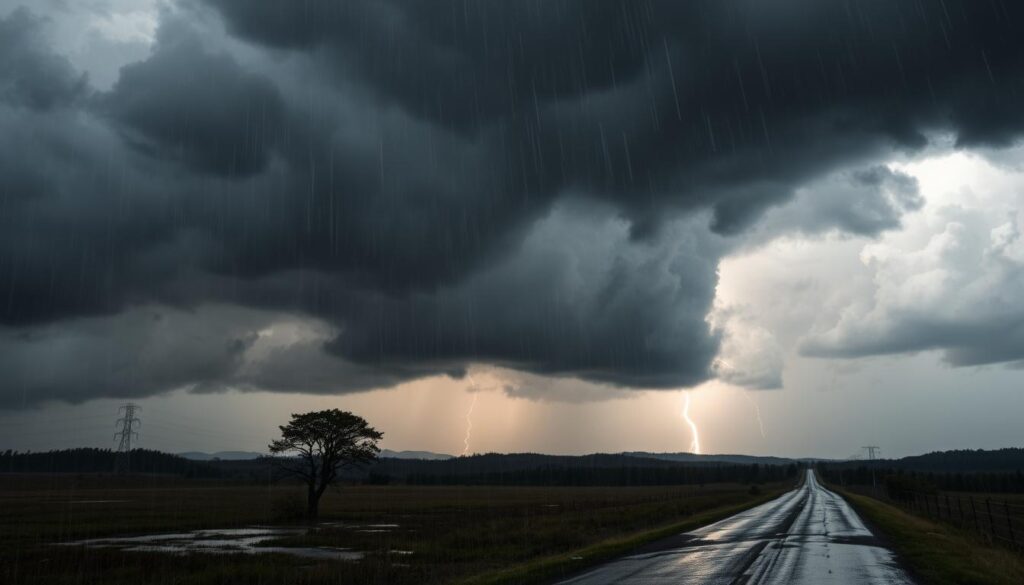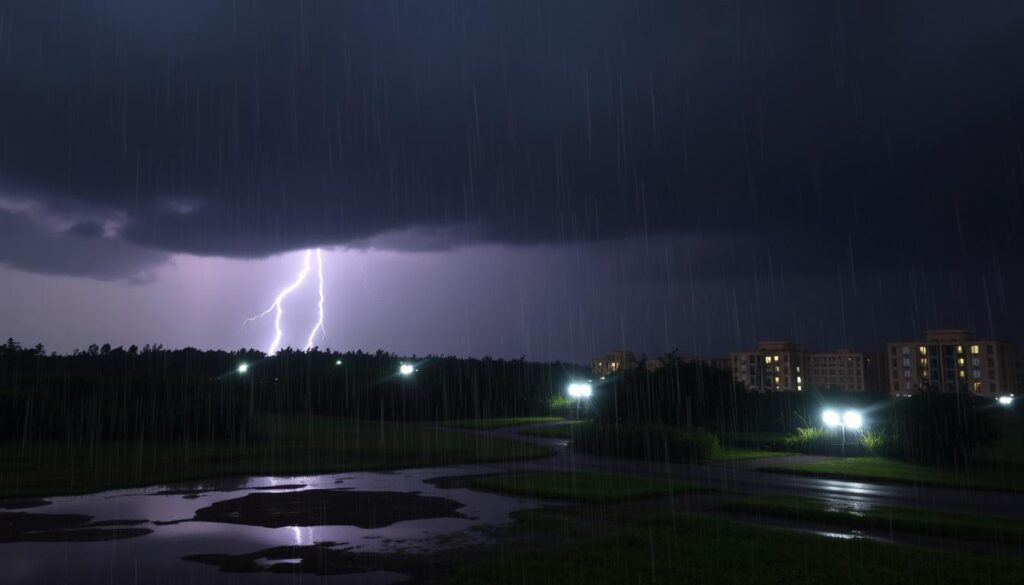Physical Address
304 North Cardinal St.
Dorchester Center, MA 02124
Physical Address
304 North Cardinal St.
Dorchester Center, MA 02124

Rainfall warning alerts to help you stay safe and prepared for the changing weather.
It’s important to stay updated on weather news, especially when there’s a rainfall warning. A warning is issued when a lot of rain is coming. It’s key to take steps to keep everyone safe.
Weather advisories and alerts help us get ready for bad weather. The National Weather Service gives us accurate forecasts. This helps us stay safe when it rains a lot.
Knowing about different rainfall warnings helps us take the right steps. By keeping up with weather news, we can avoid dangers from heavy rain. Alerts and advisories give us important info to make smart choices.
Whether it’s a little rain or a lot, being ready is crucial. It keeps us safe during rainy days.
Rainfall warnings are key for keeping us safe. Knowing the types of warnings is important. A storm watch means severe weather might happen. A flood advisory warns of possible flooding. It’s crucial to keep up with weather updates to stay safe.
Severe weather alerts are also vital. They warn us of dangers ahead. By staying informed, we can protect ourselves and our homes. Rainfall warnings can greatly affect our daily lives, so being ready is essential.
Understanding these points helps us prepare for bad weather. It’s important to stay updated on weather news. This way, we can protect ourselves and our belongings.
| Warning Type | Description |
|---|---|
| Storm Watch | Conditions are favorable for severe weather to develop |
| Flood Advisory | Warning of potential flooding |
| Severe Weather Alert | Warning of potential dangers due to severe weather |
Keeping up with the latest weather updates is key, especially when severe weather hits. A weather advisory gives timely info on potential dangers. This lets people take the right steps to stay safe. Thanks to modern tech, staying on top of the weather is easier than ever.
Many tools and resources help keep you informed. Mobile apps, weather websites, and social media are popular choices. They offer real-time updates, precipitation alert systems, and detailed forecasts. Using these tools helps people make smart choices about their day and plan ahead.
Some important features of these tools and resources include:
By using these tools, people can stay safe and informed during bad weather. It’s vital to keep up with the latest weather advisory and precipitation alert systems. This ensures you get timely info on potential dangers.
Remember, staying informed is crucial for safety during severe weather. By using the available tools and resources, individuals can make smart choices. This helps protect themselves and their loved ones.
It’s important to know the levels of rainfall warnings to stay safe. A rainfall warning means heavy rain is coming. Each warning level has its own set of guidelines and precautions.
A storm watch means severe weather, like heavy rain, is possible. You should keep an eye on the weather during a storm watch. A rainfall warning means heavy rain is likely. It’s very important to take safety steps during this time.
A light rainfall advisory is for light rain that won’t disrupt much. Still, it’s good to stay aware and take precautions.
A moderate rainfall warning means rain will cause some trouble. It’s key to keep up with weather updates during this warning.
A heavy rainfall alert warns of heavy rain that could cause big problems. It’s very important to be safe during this alert.
An extreme rainfall emergency is for extreme rain that’s very dangerous. You must act fast and follow evacuation orders.
Here’s a quick look at the different rainfall warning levels:
| Classification | Description |
|---|---|
| Light Rainfall Advisory | Light rainfall expected, minimal disruptions |
| Moderate Rainfall Warning | Moderate rainfall expected, some disruptions |
| Heavy Rainfall Alert | Heavy rainfall expected, significant disruptions |
| Extreme Rainfall Emergency | Extreme rainfall expected, life-threatening conditions |
When a flood advisory or severe weather alert is issued, having a ready emergency kit is crucial. It ensures your safety and well-being. Your kit should have non-perishable food, a first aid kit, and other vital items for the storm.
A basic emergency kit should have the following items:
It’s also wise to include important documents like insurance policies and identification in your kit. Don’t forget a severe weather alert radio or a weather app on your phone. This helps you stay updated on weather conditions.
Creating an emergency weather kit is key to staying safe during flood advisories or severe weather. Always check your kit to ensure it’s fully stocked and up-to-date. Replace any expired or damaged items.
| Item | Quantity | Importance |
|---|---|---|
| Water | 3 gallons per person | High |
| Non-perishable food items | 3-day supply | High |
| First aid kit | 1 per household | High |
It’s important to know about rainfall warning signals to stay safe during bad weather. Alerts and advisories tell us about flooding, heavy rain, and other dangers. Knowing what these signals mean helps us make smart choices to keep ourselves and our stuff safe.
When you hear about a precipitation alert, keep an eye on local news and weather reports. A weather advisory gives us important details about the weather and what we should do. By understanding these signals, we can protect ourselves and our property.
Weather maps are great for understanding rainfall warnings. They show where and how bad the weather is. This helps us know where to stay safe and avoid danger.
Radar images are also key for knowing about rainfall warnings. They show where rain is and how strong it is. By looking at these images, we can see where storms are and stay away from them.
Weather bulletins give us all the details about warnings. They tell us where, how bad, and for how long the weather will be. By understanding these bulletins, we can make good choices to stay safe. It’s important to keep up with local news and follow what authorities say.
| Type of Warning | Description |
|---|---|
| Precipitation Alert | A warning issued when heavy rainfall is expected, potentially leading to flooding or other hazardous conditions. |
| Weather Advisory | A statement issued when weather conditions are expected to be hazardous, but not necessarily life-threatening. |
When a storm watch is issued, it’s crucial to take safety steps. Stay indoors, avoid travel, and watch the weather closely. A flood advisory is serious, as it can cause severe flooding and damage.
Some key safety measures to take during heavy rainfall events include:
Be aware of the risks like flash flooding and landslides. By taking precautions and staying informed, you can lower your risk of injury. Remember, safety should always be the top priority during severe weather events.

By following these safety measures and staying informed, you can stay safe during heavy rainfall. It’s always better to be prepared and take necessary precautions during a storm watch or flood advisory.
| Safety Measure | Importance |
|---|---|
| Staying indoors | High |
| Avoiding travel | High |
| Staying informed | High |
Keeping up with the weather is now easier than ever. Thanks to many technologies and apps, we can get weather advisories and alerts quickly. This helps us stay safe by knowing what’s coming.
There are many ways to get weather updates. Apps give us real-time info, radar images, and forecasts. You can even set them to alert you for heavy rain or storms. Mobile alert systems send emergency messages to your phone during bad weather.
Social media is also a great way to track the weather. Weather services and emergency teams post updates on their social media. By following them, you can stay updated and stay safe.
There are many misconceptions about rainfall warnings. This can cause confusion and even danger. It’s important to know the difference between a storm watch and a rainfall warning. A storm watch means severe weather might happen, but it’s not a sure thing.
Some think a rainfall warning means flooding is likely. But it’s not just about flooding. It can also mean heavy rain, strong winds, or hail. Always check the latest weather news and take action when a warning is issued.
There are many weather myths to debunk. For example, some think a rainfall warning only matters if it’s raining a lot. But that’s not right. A warning can be issued even if it’s not raining hard, if the weather looks like it might get worse.

It’s key to know the science behind rainfall warnings. This helps people make smart choices about their safety. For instance, a storm watch is different from a rainfall warning. Knowing this can help you stay safe during bad weather.
By following these tips and understanding rainfall warnings, you can stay safe. Remember, a rainfall warning is more than just a warning. It’s a call to action to protect yourself.
Heavy rainfall can damage your property. It’s important to take precautions. A flood advisory or severe weather alert can help you prepare for flooding.
Ways to protect your property include securing outdoor furniture and installing storm shutters. Also, seal any cracks or gaps in your home’s foundation. Stay informed with the latest weather updates and sign up for emergency alerts.
Here are some additional tips to help you prepare for heavy rainfall:
By taking these precautions, you can minimize damage to your property during a flood advisory or severe weather alert. Stay safe and informed with the latest weather updates.
It’s always better to be prepared for heavy rainfall, rather than waiting until it’s too late. By taking the necessary precautions, you can help protect your property and keep your loved ones safe.
| Precaution | Description |
|---|---|
| Securing outdoor furniture | Bring outdoor furniture inside or tie it down to prevent it from becoming a projectile in strong winds |
| Installing storm shutters | Install storm shutters to protect your windows from wind-borne debris |
| Sealing cracks and gaps | Seal any cracks or gaps in your home’s foundation to prevent water from entering |
Understanding rainfall warnings and staying informed about severe weather is key. It keeps you safe and protects your property. Whether it’s a light rain advisory or a heavy rain emergency, being ready makes a big difference.
Stay connected to reliable weather advisory sources. Watch radar images and weather bulletins. And have an emergency weather kit ready. This way, you can quickly and effectively respond to severe weather.
Remember, the most important thing is to stay informed and take precautions. Always put your safety first during extreme weather. By working together and following local authorities’ guidance, we can get through tough rainfall events stronger and more prepared for the future. Stay safe, stay informed, and let’s face any storm together.